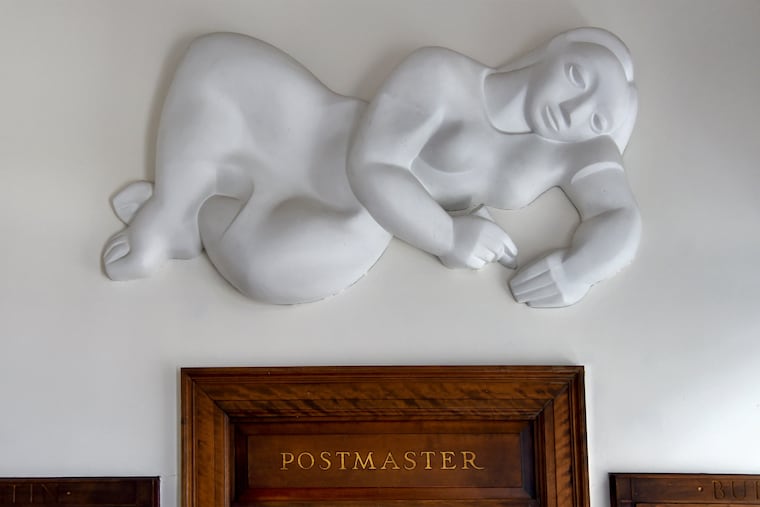At the Haddon Heights Post Office, the work of a renowned sculptor has been hiding in plain sight | Kevin Riordan
A sculpture entitled "The Letter" and created by the renowned sculptor Isamu Noguchi has graced the interior of the Haddon Heights Post Office for nearly 80 years.

In the dozen years I’ve regularly used the Haddon Heights post office, I haven’t paid much attention to the sleek, sinuous sculpture high on a lobby wall.
I hadn’t noticed that the stylized, rather voluptuous, recumbent woman it depicts is writing a letter.
Nor did I know that the piece is called The Letter — let alone that it’s the work of Isamu Noguchi, one of the greatest American sculptors of the 20th century, in whose honor the U.S. Postal Service once issued a set of stamps.
Now I know, thanks to Marshall Hatfield, a local history buff who describes the provenance of this rather fabulous piece of public art in the Haddon Heights Business and Professional Association’s 2019 community calendar. This handy publication is being distributed free throughout the borough.
“When I heard about this sculpture," Hatfield told me, "I thought, 'This is kind of cool.’”
So is the story behind it, which, like the sculpture itself, seems to get rediscovered every so often by historians and journalists.
The Letter is one of 1,400 sculptures or murals commissioned for post offices nationwide, thanks to New Deal arts support programs instituted by President Franklin D. Roosevelt’s administration.
The Haddon Heights piece is the only one created for a post office by Noguchi, whose glorious News, a gleaming exterior bas-relief at 40 Rockefeller Center, is my particular favorite. Much later, he designed a controversial sculpture you may have noticed at the plaza on the Philadelphia side of the Ben Franklin Bridge.
It’s known as Bolt of Lightning or Lightning Bolt or, according to Philadelphia Magazine, “the ugliest piece of public art” in the city.
But Haddon Heights “got lucky,” said Hatfield. “Noguchi wanted to do something in New York, where he was living, or Los Angeles, where he was born, but there weren’t any projects available in those places. Haddon Heights was available.
“Noguchi needed the money,” Hatfield said. “He probably thought, ‘Haddon Heights is not so far away from New York.’ And he did come here a number of times,”
Hatfield did research online at the National Archives (“my eureka moment”), and also obtained information from the Smithsonian Institution’s National Postal Museum and the Noguchi Museum in Long Island City, Queens. He read 85 pages of handwritten and typewritten correspondence between Noguchi and the U.S. Treasury Department and others.
Some of the exchanges involved then-Haddon Heights Postmaster Henry McKay — who, to say the least, didn’t much care for the finished product.
“I wish at this time to object to the figure installed,” McKay wrote a Treasury official on March 30, 1939, about the new artwork claiming pride of place above the door to his office. "It is too large for the space and the figure itself is objectionable, rather than attractive. We have yet to hear a single favorable comment and there has been a great deal of ridicule and unfavorable mention.
“I really think it should be removed and something more appropriate installed.”
Fortunately, the postmaster’s request was not granted. Inslee A. Hopper, of Treasury’s fine arts section, wrote a letter to McKay describing the sculpture as "an outstanding example of Mr. Noguchi’s work and I believe the interest [in it] will only increase as time goes by.”
Which has been proved true, more or less.
“That Thing? It’s Famous?” was the headline of a 2005 New York Times story about the Noguchi of Haddon Heights by Rowan University professor of art history Fred Adelson.
“The piece is quite handsome,” said Adelson, of Cherry Hill. “It’s in the spot where it was originally installed, where it was meant to be located, and it sort of flows above the doorway to the postmaster’s office.”
Alice Boland, the current postmaster, said patrons often are curious about the sculpture — as were several I interviewed during a recent visit.
“I’m excited to show this to my daughter,” said Rachel Yi, 40, who manages the office of a medical practice. “She’s interested in art, and this artist is Asian American, so it will be a point of conversation with her.”
Roberta Stevenson, whose husband, John, is the pastor of Haddon Heights Baptist Church, likes the sculpture but “can understand why in the 1930s” some local folks were not enthusiastic.
I agreed, noting that the woman writing the letter is, after all, nude.
“No, she isn’t,” Stevenson said. “Look."
The pastor’s wife is right.
To appreciate the sculpture, she said, smiling, “you have to really look at it.”
Amen.